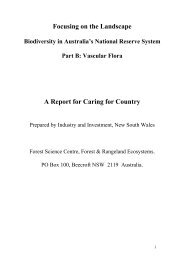Biodiversity in Australia's National Reserve System - Part ... - BushBlitz
Biodiversity in Australia's National Reserve System - Part ... - BushBlitz
Biodiversity in Australia's National Reserve System - Part ... - BushBlitz
Create successful ePaper yourself
Turn your PDF publications into a flip-book with our unique Google optimized e-Paper software.
Whilst there are a number of species of land snails with a relatively large number of records<br />
available for them, the reality is that most species have very few records available by which<br />
to assess their representation <strong>in</strong> the NRS. One thousand, one hundred and eighty seven land<br />
snails had 10 or fewer <strong>in</strong>dividual site records <strong>in</strong> the ANHAT database and so are not able to<br />
be practically assessed (Table 57). Furthermore, for many of these species, the <strong>in</strong>formation<br />
is so poor, it is impossible to assign them a preferred habitat. In many <strong>in</strong>stances, the snail is<br />
known only by a reference number and relatively few specimens. Information on the<br />
habitats <strong>in</strong> which they were collected is not available, nor are there any observations of their<br />
habits. In this case, only very broad assumptions can be made about their requirements and<br />
any assessments made with due caution. There are so many species present <strong>in</strong> this group that<br />
essentially all areas of Australia are covered and it is not reasonably practical to po<strong>in</strong>t to any<br />
trends <strong>in</strong> the data. The presence of large highly localised radiations <strong>in</strong> particular genera also<br />
means that the species are highly localised and so are not likely or even able to provide large<br />
numbers of site records. Hence, the apparently large numbers of poorly recorded snails for a<br />
particular region (e.g. Kimberley) may not represent as an important region of poorly<br />
collected species as apparent (although it still can not be ignored). The listed snails<br />
encompass a broad range of habitats, but species dependent on rocky sites are present <strong>in</strong><br />
larger numbers than may be anticipated. Species present <strong>in</strong> arid or semi-arid areas <strong>in</strong><br />
particular are dependent on such sites and are likely to be highly endemic where rocky areas<br />
are isolated.<br />
Table 57 Land snail species with 10 or fewer <strong>in</strong>dividual record sites <strong>in</strong> the ANHAT<br />
database.<br />
Species<br />
No.<br />
Records<br />
% <strong>in</strong><br />
NRS Location<br />
Veg<br />
type<br />
Area<br />
(km 2 )<br />
EPBC<br />
status<br />
76 novae 1 0.0 100 NL<br />
761 novae 1 0.0 100 NL<br />
84 novae 1 0.0 100 NL<br />
Allocharopa ersk<strong>in</strong>ensis 1 100.0 SE For 300 NL<br />
Amphidromus cognatus 1 0.0 NC WL 100 NL<br />
Amplirhagada 22 1 0.0 NW RH 100 NL<br />
Amplirhagada 24 1 0.0 NW RH 100 NL<br />
Amplirhagada 66 1 0.0 NW RH 100 NL<br />
Amplirhagada 69 1 0.0 NW RH 100 NL<br />
Amplirhagada 71 1 0.0 NW RH 100 NL<br />
Amplirhagada 72 1 0.0 NW RH 100 NL<br />
Amplirhagada 73 1 0.0 NW RH 100 NL<br />
Amplirhagada alta 1 0.0 NW RH 100 NL<br />
Amplirhagada constricta 1 0.0 NW 100 NL<br />
Amplirhagada hc 1 1 0.0 NW 100 NL<br />
Auriculastra nevillei 1 0.0 NE 100 NL<br />
Austrochloritis br 2 1 0.0 EC 100 NL<br />
Austrochloritis mv 9 1 0.0 RF 100 NL<br />
Austrochloritis nn 4 1 0.0 EC For 100 NL<br />
Austrochloritis vc 3 1 100.0 EC For 100 NL<br />
*Bothriembryon location 5 1 100.0 SW RH 100 NL<br />
Bothriembryon aff barretti 1 0.0 SW RH 100 NL<br />
Bothriembryon attenuata 1 100.0 SW RH 100 NL<br />
84






